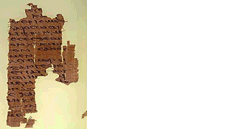
|
|
|
|
|
Research
|
|
|
|

Topics
There are two types of research papers you may write for this course,
an exegetical paper which explores a biblical passage with a particular
critical method, the other a theoretical paper, which explores the
method alone. Each is described more fully below. Within these broad
parameters, you are free to select the New Testament passage and/or
method. If you choose to do an exegetical paper, you are encouraged
to discuss your choice with the professor, because the text you choose will determine
to some extent the range of methods that might be applied fruitfully
to it. As students choose topics, their names and e-mail
addresses will be accessible from this page so that you can contact
them to share resources and ideas.
 |
- Exegetical
Paper
- The
exegetical research paper allows you to focus on both a
particular New Testament passage and a particular critical
method. As mentioned above, certain passages
lend themselves to certain methods, so the choice of one
will suggest the choice of the other. The guides
to the exegetical methods available from the Exegesis tab
above provide introductions and steps for each method, as
well as a bibliography of studies examining each method
and applying it to biblical passages. A review
of these pages will help you to decide which method, if
not which passage, may interest you. You may
also be interested in reviewing the Scripture Tools page
with its nested references to New Testament manuscripts
and versions (see tab at the top of this research page).
-
- Researchers:
|

Bibliography |
 |
- Theoretical
Paper
- The
theoretical paper focuses not on a biblical passage and
critical method, but on the critical method alone. In this
type of paper, your goal is to read enough theoretical and
applied studies so that you can determine the origins, benefits
and shortcomings of your method.
-
- Each
of these sections will in turn address a body of questions.
For the origins section, determine not only when the method
flourished but what factors gave rise to it, where it was
practiced, who its leading advocates were, and what the
chief studies were. For the benefits section, be prepared
to discuss the chief insights that the method yields; you
may wish to incorporate some examples from the scholarship
that apply the method to New Testament texts in a fruitful
way. Consider what this method yields to readers that prior
methods could not, that is, how the method advanced human
understanding of the biblical text. Finally, for the shortcomings
section, you will want to consider inherent flaws in the
method as well as the kinds of questions that the method
does not or cannot address. The easiest way to determine
these matters is to consider the methods that arose immediately
afterward, because these often develop as a reaction to
the shortcomings of a prior method. The Pontifical Biblical
Commission document, "The Interpretation of the Bible
in the Church," will also provide some ideas about
the limits of your chosen critical method.
-
- Researchers:
|

Bibliography |
|
|
|
|
|
